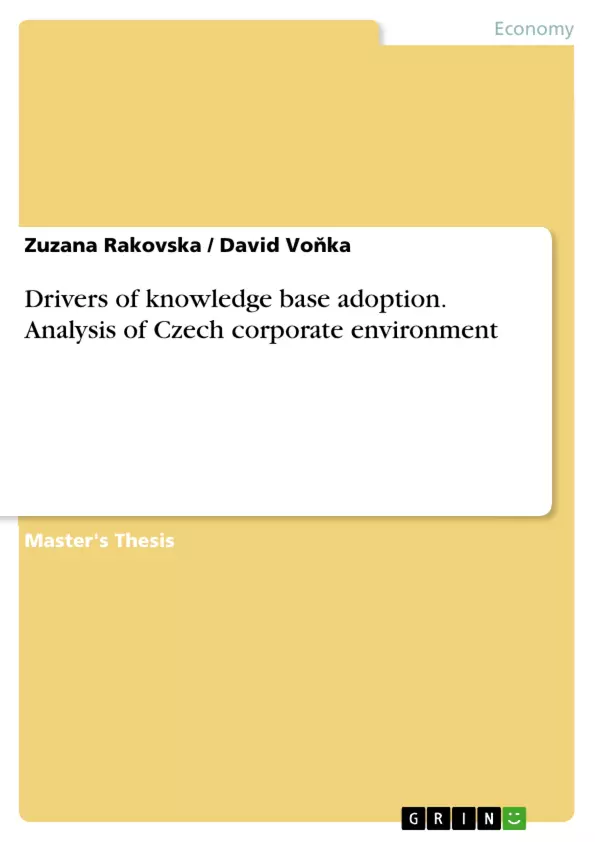This paper analyses the process of knowledge-base adoption in the enterprise environment. Using data from two knowledge-management systems operated by the company, Semanta, s.r.o. we studied the day-to-day interactions of employees using the system and identified the important drivers of system adoption. We began by studying the effect of co-workers' collaborative activities on knowledge creation within the system. It was found that they had a positive and significant impact upon overall knowledge creation and thus on adoption. Secondly, we explored how the newly defined concept of gamification could help determine and encourage an increase in knowledge creation. The use of gamification tools, such as the "Hall of Fame" page, turned out to have significant influence in the adoption process. Thirdly, we examined how users continually seek knowledge within the system and how asking for missing information and being supplied with answers has an impact on adoption rates. It was shown that the quicker the responses and the more experts dealing with requests the greater the impact on knowledge base adoption. Finally, we showed that the size and character of the company deploying the knowledge management system does not influence the adoption drivers. This paper represents an effort to fill the literature gap surrounding effective knowledge-base adoption in an intra-company environment. Moreover, as far as we know, it represents the first attempt to estimate the relationship between gamification concepts and knowledge-base adoption not only in the Czech Republic but also worldwide.
Inhaltsverzeichnis (Table of Contents)
- Chapter 1
- Introduction
- Chapter 2
- Literature Review and Theoretical Background
- Critical Success Factor approach
- Technology Acceptance Model
- Gamification
- Literature Review and Theoretical Background
- Chapter 3
- Design and Elements of Knowledge Bases
- Chapter 4
- Hypotheses
- Hypothesis #1
- Hypothesis #2
- Hypothesis #3
- Hypotheses
- Chapter 5
- Data
- Knowledge Management Systems
- Capturing the Data
- Data for the First Hypothesis
- Data for the Second Hypothesis
- Data for the Third Hypothesis
- Data
- Chapter 6
- Methodology
- Poisson Regression and Negative Binomial Model
- Zero-Inflated Negative Binomial Model
- Random Effects Negative Binomial Model
- Testing
- Methodology
- Chapter 7
- Results
- Results for the First Hypothesis
- Results for the Second Hypothesis
- Results for the Third Hypothesis
- Results
Zielsetzung und Themenschwerpunkte (Objectives and Key Themes)
This paper explores the adoption of knowledge bases within the enterprise environment, focusing on the drivers of knowledge-base adoption. The study utilizes data from two knowledge management systems operated by Semanta, s.r.o., analyzing the day-to-day interactions of employees with the systems to identify key factors influencing adoption.
- The impact of co-workers' collaborative activities on knowledge creation and adoption.
- The influence of gamification techniques in driving knowledge creation and adoption.
- The relationship between user requests for missing information and knowledge base adoption.
- The role of company size and character in influencing adoption drivers.
- Filling the literature gap surrounding effective knowledge-base adoption in an intra-company environment.
Zusammenfassung der Kapitel (Chapter Summaries)
Chapter 1: Introduction This chapter introduces the concept of knowledge management and its importance in today's business environment. It highlights the significance of knowledge-base adoption for companies to achieve cost reduction and competitive advantage. The chapter emphasizes the need for employees to be willing to share their knowledge and utilize the corporate information for effective knowledge management.
Chapter 2: Literature Review and Theoretical Background This chapter provides a comprehensive review of existing literature on knowledge-base adoption. It explores three key theoretical frameworks: the Critical Success Factor approach, the Technology Acceptance Model, and gamification. These frameworks serve as the foundation for the study's hypotheses and analysis.
Chapter 3: Design and Elements of Knowledge Bases This chapter delves into the design and key elements of knowledge bases. It discusses the features and functionalities of knowledge management systems and their role in facilitating knowledge creation, sharing, and utilization.
Chapter 4: Hypotheses This chapter presents the research hypotheses that guide the study. The hypotheses explore the relationships between specific factors, such as collaborative activities, gamification, user requests, and company characteristics, and knowledge-base adoption.
Chapter 5: Data This chapter outlines the data sources and collection methods employed in the study. It describes the knowledge management systems used by Semanta, s.r.o., and the data capturing techniques employed to analyze employee interactions with the systems.
Chapter 6: Methodology This chapter details the statistical methods used to analyze the collected data. It introduces the Poisson regression, negative binomial model, zero-inflated negative binomial model, and random effects negative binomial model, highlighting their relevance to the study's objectives.
Chapter 7: Results This chapter presents the findings of the study, focusing on the results obtained for each of the research hypotheses. It analyzes the statistical significance of the relationships identified between the independent variables (factors influencing adoption) and the dependent variable (knowledge-base adoption).
Schlüsselwörter (Keywords)
The study focuses on the key concepts of knowledge base, gamification, knowledge-base adoption, and knowledge management system. These terms encompass the primary themes and concepts of the work, including the impact of gamification on knowledge creation and the factors driving adoption within a corporate environment. The research also utilizes JEL Classification codes (J24, O15, O34, O35, O52) to categorize its focus areas.
- Quote paper
- Zuzana Rakovska (Author), David Voňka (Author), 2015, Drivers of knowledge base adoption. Analysis of Czech corporate environment, Munich, GRIN Verlag, https://www.grin.com/document/317285



